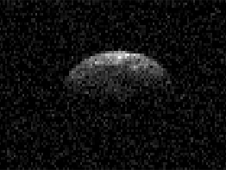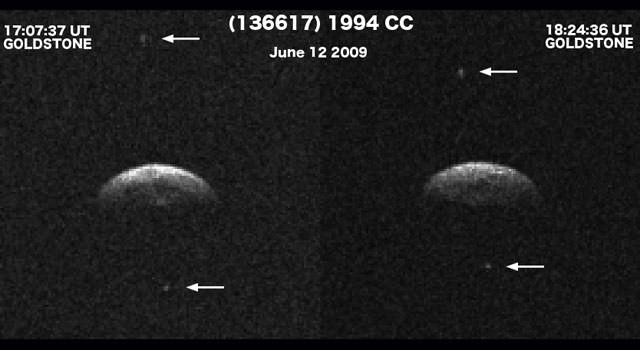[/caption]
Radar images have shown that a near-Earth object is actually a triple system; an asteroid with two small moons. NASA’s Goldstone Solar System Radar on June 12 and 14, 2009, revealed the new informaton about Asteroid 1994 CC. It came within 2.52 million kilometers (1.56 million miles) on June 10. Prior to the flyby, very little was known about this celestial body. 1994 CC is only the second triple system known in the near-Earth population. A team led by Marina Brozovic and Lance Benner, both scientists at NASA’s Jet Propulsion Laboratory in Pasadena, Calif., made the discovery.

1994 CC consists of a central object about 700 meters (2,300 feet) in diameter that has two smaller moons revolving around it. Preliminary analysis suggests that the two small satellites are at least 50 meters (164 feet) in diameter. Radar observations at Arecibo Observatory in Puerto Rico, led by the center’s director Mike Nolan, also detected all three objects, and the combined observations from Goldstone and Arecibo will be utilized by JPL scientists and their colleagues to study 1994 CC’s orbital and physical properties.
The next comparable Earth flyby for asteroid 1994 CC will occur in the year 2074 when the space rock trio flies past Earth at a distance of two-and-a-half million kilometers (1.6 million miles).
Of the hundreds of near-Earth asteroids observed by radar, only about 1 percent are triple systems.
Source: JPL


Jorge,
When imaging near-earth asteroids, Arecibo is used in its active radar mode. So, it does emit a pulse towards the asteroid.
Go to the Arecibo research page at:
http://www.naic.edu/public/research.htm
and look that the entry under “Radar Astronomy”
Manu:
I think the image released by JPL and Goldstone has been processed and can (to first order) be simulate what an observer floating in space would roughly “see”.
See Chris Magri’s (one of the 1994CC observers)
page about radar studies of the main-belt asteroid
216 Kleopatra.:
http://academic.umf.maine.edu/~magri/NASC/kleopatra.html
I have a doubt on these radar images.
The common understanding of radar systems implies a radio transmitter which emits radio waves and a receiver which is used to receive those radio waves that get reflected by the objects in front of the transmitter.
But in this case, there is no transmitter, is there? Arecibo works simply as a receiver, detecting the fraction of radio waves originally emitted by the Sun that get reflected by those asteroids. Which is why we see them as crescent. Isn’t it so?
If it is so, then why are these images called “radar” images, and not “radio” images, like visible, infrared, ultraviolet images, and so on?
That’s a neat little surprise!
It’s even more complicated, these radar images are NOT a sort of radar flash-photography.
As Emily Lakdawalla explains, “Doppler-delay images plot Doppler shift on the horizontal axis and distance from the telescope on the vertical axis.” (from her blog at planetary dot org slash blog; she also displays a noise-reduced version of the anim).
Meaning: radar gives you 2 kinds of information. The time-delay gives object distance; frequency shift (‘Doppler shift’) gives radial velocity respective to Earth.
Plotting these two as coordinates on a graph produces something that looks like an image, but is not!
I fail at understanding how this ‘image’ actually relates to the object as we would see it, where is the observer’s direction (if any), etc.
Anyone knows of a webpage where this is clearly explained, with graphics?
Awesome. Did they get enough data to determine the mass?
Hm… I see I had a totally wrong idea about how this works.
And the fact that nobody seems to understand it very well (or at least be able to explain it properly) may be an indication that maybe a generic article on the issue might be a good thing to publish by Universe Today.
What do you say, staff? 😉
Jorge, you might want to check out the ‘mandatory’ Wiki page on “radar astronomy” and its related links here: http://en.wikipedia.org/wiki/Radar_astronomy 🙂
An a different note, does anyone know the rough inclinations of these objects to our line of sight? Or direction of orbit, for that matter?
Bernie, thanks for the link!
Manu, you’re welcome!
Wow, I didn’t know it was possible to use (some kind of) radar on objects that are 2.5 million km away.
I agree with Jorge, it would be interesting to read more about how this method of observing works exactly.
Here’s a fact filled JPL page entitled “Asteroid Radar Research” @: http://echo.jpl.nasa.gov/ with all sorts of info on current asteroid research using radar 🙂
What is the definition of near earth objects? Are they in earths “path”? If so, then by definition Earth is not a planet because it has not cleared it’s “path”.
@ yeltrah: Check out the Wiki page on Near-Earth Objects page here: http://en.wikipedia.org/wiki/Near_earth_asteroids . Lots of links and references, as usual.